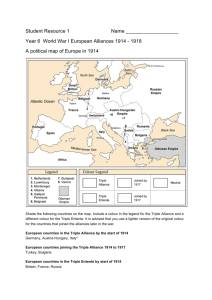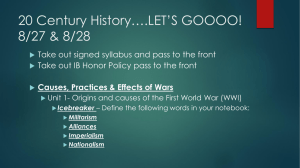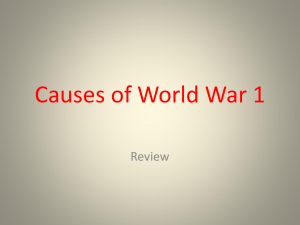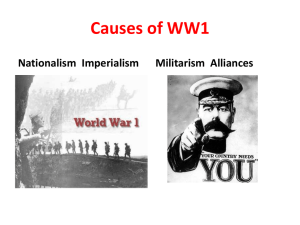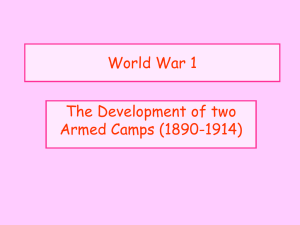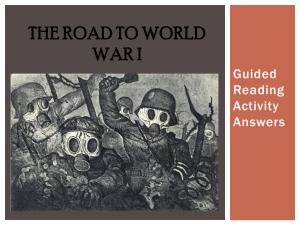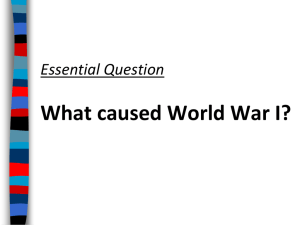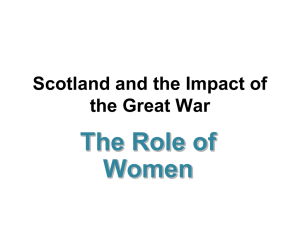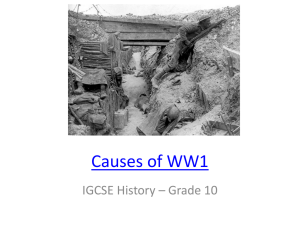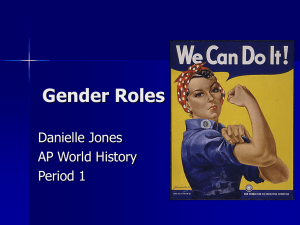Prelude to war, causes of war, alliance systems
advertisement
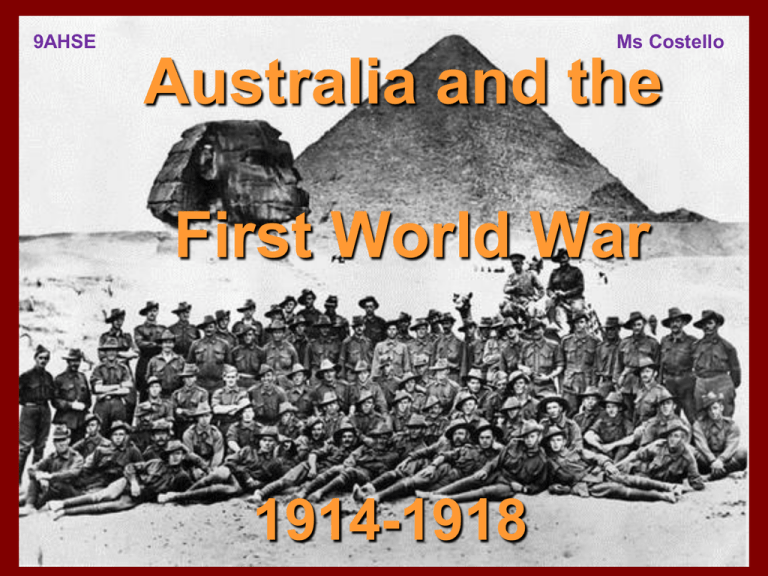
9AHSE Ms Costello Australia and the First World War 1914-1918 Prelude to War In the four decades prior to August 1914, the western world was undergoing unprecedented changes in every area of society. Industrial expansion and wealth, both personal and national, had a profound impact on economic life. These changes lead to conflicts, jealousies and differences that were not easily reconcilable. Monarchies and democracies alike sought to cope with the changes and to protect their authority. Meanwhile, as the major European nations sought to expand their wealth and territories, they also needed to protect them. Thus they looked for partners they could turn to in case of war Causes of the War Historians have traditionally cited four long-term causes of the First World War IMPERIALISM – Economic and political control over weaker nations NATIONALISM – a devotion to the interests and culture of one’s nation MILITARISM – policy of maintaining a strong military organisation in aggressive preparedness for war ALLIANCE SYSTEM – By 1907 Europe was divided into two armed camps Imperialism For many centuries, European nations built empires across the globe in order to control as much territory as they could. Reasons for Imperialism Why European nations competed with each other to gain colonies Power and prestige - The more territory that they were able to control the more powerful and important they thought they could become. Natural resources. These could be brought to Europe and turned into manufactured goods. New markets for their manufactured goods. These goods could be sold in Africa for large profits. To prevent others from taking that region The Scramble for Africa was a process of invasion, occupation, colonisation and annexation of African territory by European powers during the New Imperialism period, between 1881 and World War I in 1914 Nationalism Often nationalism led to rivalries and conflicts between nations. Additionally, various ethnic groups resented domination by others and wanted independence. Finally, Russia and AustriaHungary disagreed over the treatment of Serbs in central Europe. Germany was allied with AustriaHungary while Russia, France and Britain were partners Militarism Empires had to be defended and European nations increased military spending enormously in the late 19th and early 20th century. Britain had long ruled the seas as it had the strongest naval fleet By 1890 Germany had surpassed Britain as the strongest nation militarily in Europe Germany had a strong army and built up a navy to rival England’s fleet. France, Italy, Japan and the United States quickly joined in the naval buildup. There was fierce competition between Britain and Germany for mastery of the seas and Battleships were being stockpiled from the late 19th century. HMS Dreadnought was a battleship of the British Royal Navy that revolutionised naval power. The Germans soon followed suit introducing their own battleships. Alliance System TRIPLE ENTENTE By 1907 there were two major defense alliances in Europe The Triple Entente FRANCE BRITAIN RUSSIA (later known as the Allies) consisted of France, Britain, and Russia European Alliances in 1914 Triple Entente The Triple Entente or Allies France, Britain, and Russia 1914 Russian propaganda poster. The upper inscription reads “Agreement". The uncertain Britannia on the right and Marianne (French emblem of liberty and reason) on the left look to the determined Mother Russia (centre) to lead them in the coming war The Triple Alliance The Triple Alliance, later known as the Central Powers, consisted of Germany, Austria-Hungary, and Italy (Soon joined by the Ottoman Empire) Triple Alliance An Artists impression of the Triple Alliance. Germany is depicted on the left Austria-Hungary on the right and Italy below and centre European Alliances 1914 The Balkans This part of Europe has always been strongly subdivided culturally and linguistically from the rest of Europe due to Greek & Turkish influences Igniting a Powder Keg The Balkans The Balkan region was considered “the powder keg of Europe” due to competing interests in the area. The Balkans Russia wanted access to the Mediterranean Sea. Germany wanted a rail link to the Ottoman Empire. The Balkans Austria-Hungary, which had taken control of Bosnia in 1878, accused Serbia of subverting its rule over Bosnia. Bosnia Igniting the Powder Keg Finally, in June of 1914, Archduke Franz Ferdinand, heir to the Austrian throne was gunned down in Sarajevo, the capital of the Austro-Hungarian province of Bosnia and Herzegovina, by Gavrilo Princip, a Serbian radical igniting a diplomatic crisis. This is incident is regarded as the ‘spark’ that triggered the First World War Igniting the Powder Keg Franz Ferdinand, heir presumptive to the Austro-Hungarian throne, travelled with his wife to Sarajevo Serbian radical Gavrilo Princep travels to Sarajevo The Fighting Begins The Alliance system pulled one nation after another into the conflict – The Great War had begun. On August 3, 1914, Germany invaded Belgium, following a strategy known as the Schlieffen Plan. This plan called for a quick strike through Belgium to Paris, France. Next, Germany would attack Russia The plan was designed to prevent a two-front war for Germany. The Schliefflen Plan HISTORY Ms Costello 28.2.13 Today we will: - Review Exercise (Name the two alliance and the countries involved) - Check Bookwork policy is signed - Examining the following: - Chain of events that lead to World War - Map worksheet – Alliances and Schlieffen Plan - Australia’s enthusiasm for war - Causes of WWI wordsearch - Our class wiki http://rhhscostello.wikispaces.com/ Do now: (and do every time you walk into the classroom) 1. Take out your book, diary, pencil case, ruler - write today's date in your book 2. Write the heading (underline all headings) Today we will : and copy list above 3. Move directly on to Review Exercise • Write the heading Review Exercise in your books (and underline) • Write 5 facts, ideas, concepts that you remember from the previous lesson (Alliance systems – see above) A Chain of Events as a result of Alliances The assassination of Archduke Franz Ferdinand led to the ‘July Crisis’ and AustriaHungary declaring war on Serbia Australia stands behind the ‘Mother The Great War Country’ to ‘defend her to our last man and our last shilling’ Great Britain declares war on Germany 4th August 1914 Great Britain had an agreement to defend Belgium this brought them and all nations of the British Empire into the war as well. Assassination 28 June 1914 30 July Russia began to mobilise due to its alliance with Serbia, Germany then put the Schlieffen plan into action and declared war on Russia (1st August) 3rd August German army then launched its attack on Russia's ally, France, through Belgium COUNTRIES THAT FOUGHT IN WWI CENTRAL POWERS OR TRIPLE ALLIANCE Austro-Hungarian Empire (1914 -1918) German Empire + German colonial forces (1914 – 1918) Ottoman Empire (Turkey) secretly from 2 August 1914 & openly from 29 October 1914 – 1918 Kingdom of Bulgaria (1915 – 1918) *N.B. Italy, although an original member of the Central Powers alliance, fought on the side of the Allied Powers from 1915. The original Triple Alliance was intended to be limited to defensive purposes only. Declaring war on Serbia was aggressive and not defensive action so Italy withdrew their support and fought on the other side. TRIPLE ENTENT OR ALLIED POWERS France (1914 -1918) British Empire (1914 -1918) + all members of its Empire including Australia, New Zealand, India, Canada, South Africa Russian Empire (1914–17) Belgium (1914 -1918) Montenegro (1914–16) Japan (1914 - 1918) Serbia (1914 – 1918) *Italy (23 May 1915–18) Romania (1916–18) Portugal (1916–18) Brazil (1916-18) Greece (1917–18) United States (1917–18) + others colonies of the European Powers
